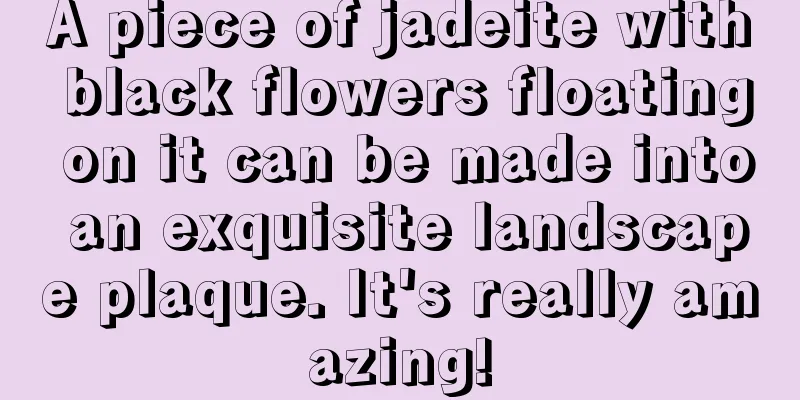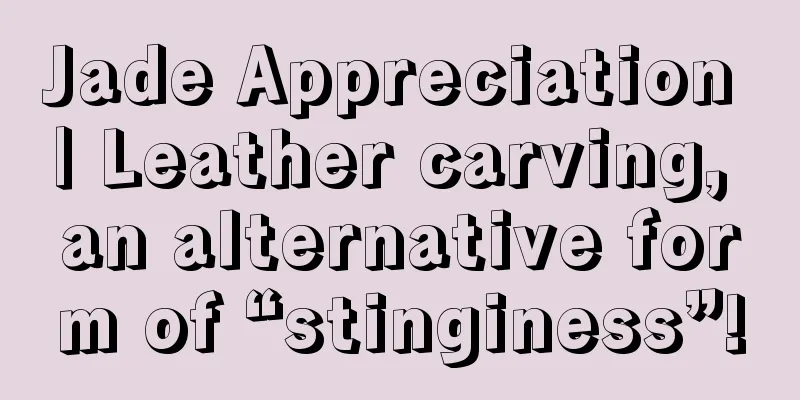A piece of jadeite with black flowers floating on it can be made into an exquisite landscape plaque. It's really amazing!

|
The color of jadeite sometimes appears to be "green turns to black". We often encounter such jadeite raw stones, which appear to be black spots at first glance, but are charmingly green when viewed under a strong light. For these, jade carvers often use skilled carving techniques to reduce the thickness of the colored parts and change the refraction angle of light entering the jade material, thereby diluting the black flower phenomenon, allowing the finished product to exude a charming green color and improving the grade of the finished product! Today I would like to share one such work with you for discussion at the university. At first glance, I guess not many people would like this piece of cut jade square plate. Although the square piece has no major cracks, its water quality is average. The most fatal thing is that there are clusters of "black flowers" floating on it. These black flowers greatly reduce the beauty and value of the jade. However, when the jade carver saw it for the first time, he couldn't help but fall in love with this piece of material. Although the jade has black flowers floating on it, the black flowers are green under the light. This shows that some carving techniques can be used to change the visual beauty of the finished product. Based on the analysis of the color depth of the black flowers and the distribution of color trends, the jade carver decided to use this jade material to carve a pendant with a landscape theme: design the distribution of mountains according to the direction of the floating flowers, and design lakes, poets, trees, buildings and other decorative elements in the part without floating flowers. The composition is rich and full in content, with a prominent theme, making full use of every feature of the jade. The jade carver uses shallow relief to carve the pattern. The advantage of this is that he can better control the thickness of the pendant and grasp the critical point where the black flowers turn green. Shallow relief carving is different from high relief carving in that it removes jade material layer by layer and slowly shapes the pattern. This way, the jade carver will find it easier to find the critical point for melting the black spots. After the jade carver's meticulous carving efforts, the rough piece of landscape pendant was finally completed. Those black clusters of colors floating on the original stone have turned into layers of dark green mountains. The rough material that was not in people's eyes at the beginning has now become a jadeite landscape square plaque that everyone is scrambling for. The polishing process is also very ingenious. The buildings, pagodas, poets and fishing boats are treated with matte finish to increase the layering of the picture; other parts are treated with bright light to make the green on the floating green flowers more blooming and dilute the gray and black feeling. Through this light refraction treatment, the finished product is more exquisite. The pattern structure on the back echoes that on the front, like a profound ink-splashed landscape painting. Finally, take a look at the charming translucent picture. Do you feel that the change is too big? fcgc99
|
Recommend
What is a variant? Do you know how important the species of jadeite is?
1: Accurately identify the quality of jadeite. Fr...
As the saying goes, "There is no jade without cotton", so how is cotton formed? What are the differences between different cottons?
As the saying goes, "There is no jade withou...
How to choose a good jade bracelet
Jade is an item that is both beautiful and practi...
Let you know about jade and its market value
Jadeite, also known as jadeite jade, jadeite and ...
Jade Story Collection: The finishing touch, the inspiration, the inlaid animal paradise
Traditional jade inlay is made by using exquisite...
Wear the jade gourd until old age, and you will have a life of happiness, prosperity and peace!
As one of the oldest mascots of the Chinese natio...
Now that high-end jadeite prices are rising, consumers are just waiting and watching but not buying
In recent years, the art market has become a focu...
The Damo pendant is carved with the yellow and green double-color jadeite of Damakan with coarse crystals. The finished product is very pleasing to the eye.
Jade lovers who like to gamble on jadeite stones ...
The strange-shaped Damakan jadeite raw stone is peeled and made into a large ornament
Damakan jade has been very popular in the market ...
What are the effects of soaking jade in water? Can it really replenish water?
I often hear people say that in the process of ja...
Jadeite Wu Shi Pai, leave three points of blank space for everything, with profound meaning
The highest state of Chinese language is to retai...
Such bold and avant-garde jade carvings are difficult to understand at first glance, but they are endless when you savor them carefully!
Jade is superior to stone because of its texture,...
Scientific jade identification, it is particularly important to understand these points
Jade was discovered by the Chinese. For hundreds ...
Tips and steps for identifying jadeite with the naked eye, methods for identifying A-grade, B-grade, C-grade and D-grade jadeite
Many friends often ask me how to judge the authen...
How to choose jadeite, you can start from these aspects
With the continuous improvement of the quality of...









